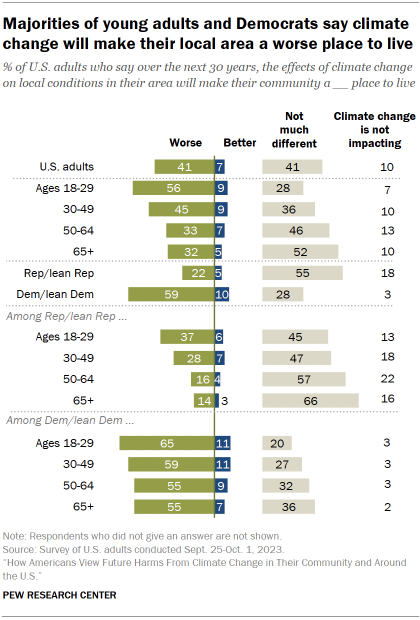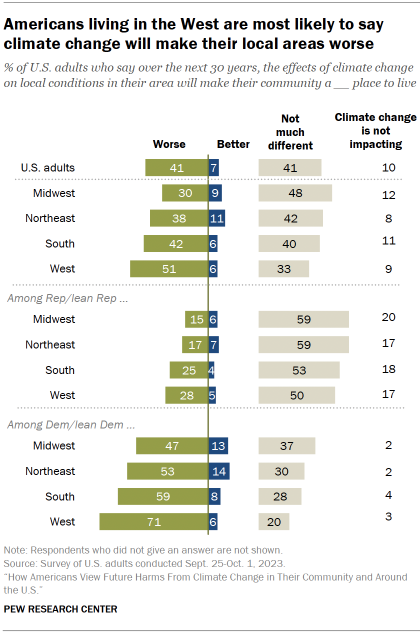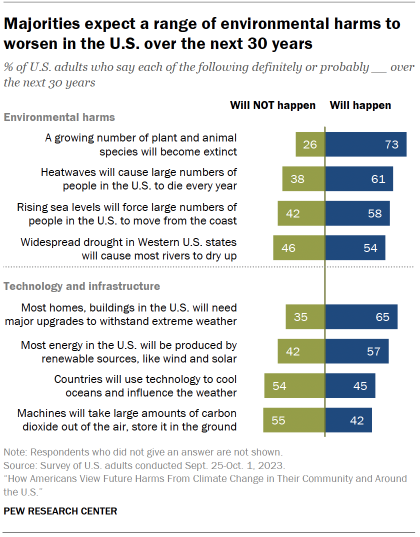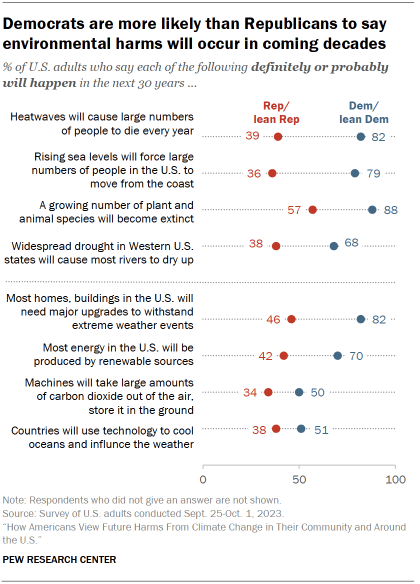Americans are far more likely to say the effects of climate change will make their local community a worse rather than better place to live over the next 30 years, but many also say they don’t expect much change in local conditions. These attitudes vary considerably by factors like age, partisan affiliation and region.
Differences by party

A majority of Democrats and Democratic leaners (59%) say they expect climate change to make conditions in their local community worse over the next 30 years. Far fewer (28%) say climate change won’t make much difference in their area and just 10% think climate impacts will improve their local conditions.
In contrast, a majority of Republicans and Republican leaners (55%) say they expect climate change to not make much difference on their community in the next 30 years. Another 22% say they expect living conditions in their local community to get worse over the next 30 years, while 5% say that living conditions will get better. Nearly two-in-ten Republicans (18%) do not believe climate change is impacting communities.
Views vary by age group
Younger adults are more likely than older adults to expect adverse impacts from climate change in their communities. Overall, 56% of young adults ages 18 to 29 say their local community will be a worse place to live because of climate change in the next 30 years, while only 9% say climate change will make their local community a better place to live. Roughly three-in-ten young adults do not think climate change will have much of an effect on conditions in their area.
By comparison, the most commonly held view among adults ages 65 and older is that climate change will not have much effect on conditions in their area (52%) over the next 30 years. About a third (32%) think climate change will make their community a worse place to live in the coming decades.
Age differences among Republicans and Democrats
Age differences are seen within both the Republican and Democratic parties when it comes to expectations about local climate impacts.
Republicans ages 18 to 29 (37%) are more likely than Republicans ages 65 and older (14%) to expect climate change to make their local communities worse. Two-thirds of older Republicans say climate change will not make much difference on conditions in their local communities, compared with 45% of younger Republicans.
The age gap is more modest within the Democratic Party. Still, the youngest Democrats are 10 points more likely than the oldest Democrats to expect their area to become a worse place to live because of climate change over the next 30 years (65% vs. 55%).
Regional differences

Across the four major U.S. regions, Westerners are most likely to expect climate change to make local conditions in their area worse, while Midwesterners are least likely to say this.
About half of adults living in the West say climate change will make their community a worse place to live. By comparison, 30% of residents in the Midwest say the same.
Americans living in the South and Northeast fall in between, with roughly four-in-ten in both regions expecting climate change to make local conditions worse over the next 30 years.
This pattern of regional differences is seen among both Republicans and Democrats, though partisans remain far apart in their expectations within each region.
For example, in the West, 71% of Democrats and 28% of Republicans expect conditions in their community to worsen over the next 30 years. By comparison, in the Midwest, relatively smaller shares of both groups expect climate change to make their community a worse place to live, though Democrats remain much more likely than Republicans to say this (47% vs. 15%).
Expectations for future environmental problems, tech advances

Asked to think more broadly about future environmental conditions, Americans see a range of negative impacts as likely to come to pass.
About three-quarters of Americans say a growing number of plant and animal species will definitely or probably become extinct over the next 30 years.
Majorities also see other environmental harms as likely to happen:
- 61% say heatwaves will definitely or probably cause large numbers of people in the U.S. to die every year.
- 58% think rising sea levels will force large numbers of people to move away from coastal areas over the next 30 years.
- 54% expect widespread drought in the Western U.S. states will cause most rivers to dry up.
These questions did not directly ask about the role of climate change on these environmental harms. However, Americans who see climate change as a serious problem are much more likely than those who see it as a less serious problem to say each of these environmental harms will probably or definitely happen. For example, 85% of Americans who describe climate change as an extremely or very serious problem say heatwaves will definitely or probably cause large numbers of people to die over the next 30 years. Among those who see climate change as a not too serious problem or not a problem, just 16% say this. (Read the Appendix for more details on this analysis.)
The survey also asked Americans about how technology and infrastructure may change in response to environmental conditions.
About two-thirds of Americans say most homes and buildings will definitely or probably need major upgrades to withstand extreme weather events over the next 30 years. A smaller majority (57%) expects that renewable sources will produce most of the country’s energy in 30 years. In 2022, renewable energy sources – such as wind, solar and hydropower – were used to generate about 22% of total electricity in the U.S.
Other forms of technology are currently less widespread, but could be further developed in future decades. Direct air capture is a technology that involves machines removing carbon dioxide from the atmosphere, which the U.S. Department of Energy plans to build and use in coming years. Other technologies are in development that aim to cool oceans and influence weather through various approaches.
Sizable shares of Americans, but not majorities, expect these emerging technologies to become commonplace in the next 30 years:
- 45% of Americans say it is definitely or probably likely that countries will use technology to cool oceans and influence the weather.
- 42% say it is definitely or probably likely that machines will take large amounts of carbon dioxide out of the air and store it in the ground.
Partisans differ in expectations for future environmental conditions

Democrats are much more likely than Republicans to expect both worsening environmental harms and changes in technology and infrastructure over the next 30 years.
Roughly eight-in-ten Democrats say heatwaves will definitely or probably cause large numbers of people to die in the U.S. each year and that rising sea levels will force large number of Americans to move away from the coast.
By contrast, fewer than half of Republicans expect these environmental harms to happen over the next three decades.
On infrastructure and technological changes, Democrats (82%) are more likely than Republicans (46%) to say homes and buildings will need major upgrades to withstand extreme weather events. And a majority of Democrats (70%) expect most energy in the U.S. to be produced by renewable sources in 30 years, compared with fewer than half of Republicans (42%) who expect this to happen.
Partisan gaps are smaller over the emerging technologies of carbon capture and ocean cooling, with neither group confident that these technologies will be in place. Still, Democrats are somewhat more likely than Republicans to think both large-scale carbon capture (50% vs. 34%, respectively) and geoengineering to cool oceans (51% vs. 38%) are likely in 30 years.




